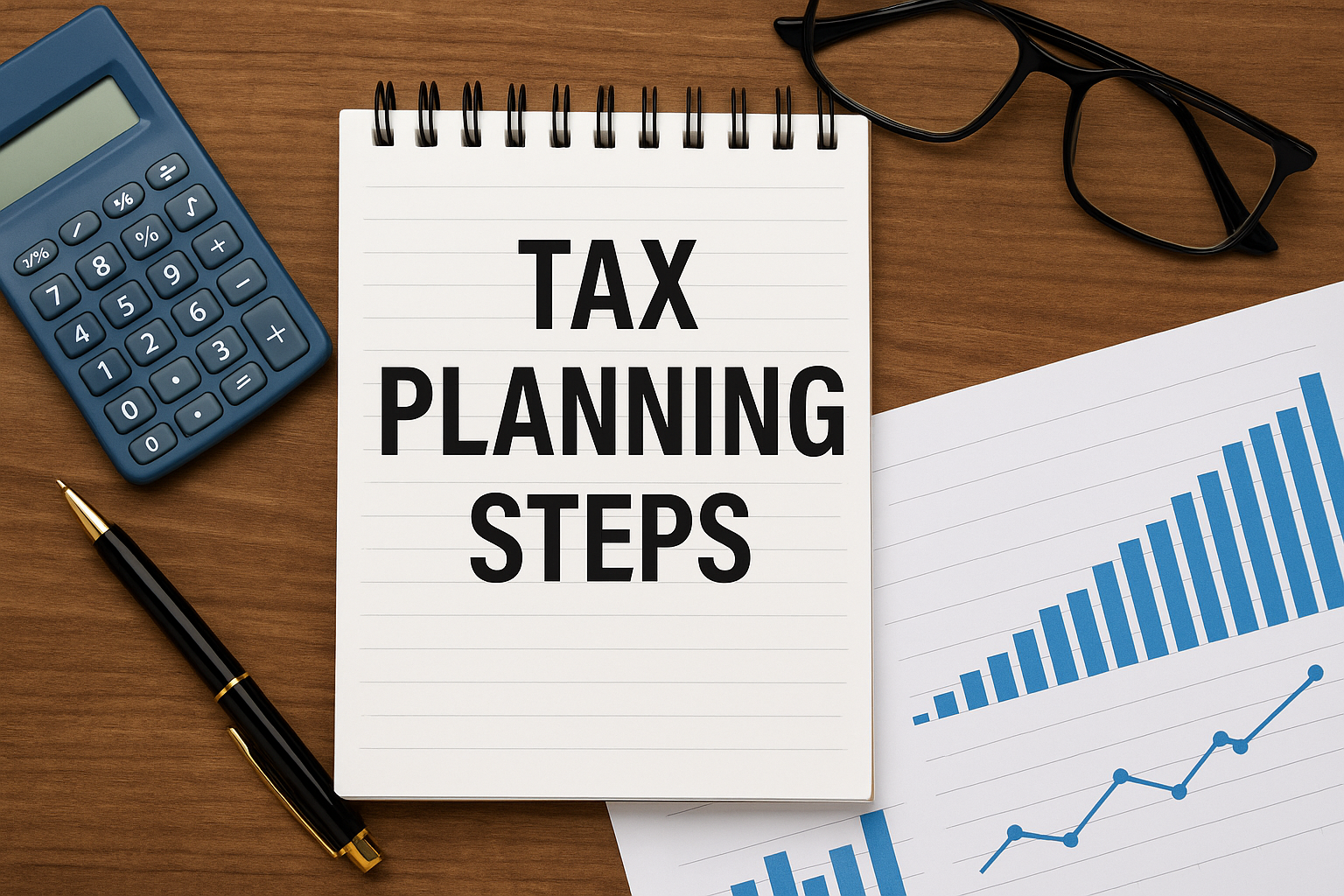5 Simple Tax Planning Steps to Save More Money and Avoid Costly Mistakes


Let’s be real for a second: when most people hear the word “taxes,” their brain immediately wants to take a nap. Tax season is rarely on anyone’s top-ten favorite activities list. But here’s the truth: if you plan ahead—even with a few simple moves—you can make the whole process easier, less stressful, and way more manageable.
Today, I’ll walk you through five simple tax planning steps that completely changed the way I handle my money. Don’t worry—I’m not a tax pro or accountant, just a blogger who learned through trial and error.
👉 Quick disclaimer: This post is for general informational purposes only. It’s not financial, tax, or legal advice. Please consult a licensed professional for personalized guidance.
Why Tax Planning Steps Matter
Most people only think about taxes in March or April, frantically digging through receipts and forms. But here’s the thing: if you plan throughout the year, you can smooth out the stress and even align your taxes with your bigger financial goals.
A study from the IRS shows that over 60% of U.S. taxpayers end up with refunds each year. While refunds feel great, it also means you’ve essentially given the government an interest-free loan. Smart tax planning steps can help you strike a balance—so you’re not overpaying or underpaying.
Step 1: Get Organized Early
Tax planning isn’t about advanced math or legal jargon—it starts with good old-fashioned organization.
Picture this: it’s April, and instead of panicking, you already have all your documents neatly stored in one place. Sounds dreamy, right?
Here’s how I do it:
- Create a digital folder titled “Taxes 2024.”
- Drop in every W-2, 1099, or income statement as soon as you get it.
- Snap photos of paper receipts and upload them to Google Drive or Dropbox.
I used to keep a shoebox stuffed with random papers. Every year I’d swear, “Never again!”—and then repeat the same chaos. Once I went digital, my stress level dropped instantly.
Step one is all about getting organized. Keep copies of W-2s, 1099s, receipts, and other important papers in one safe place. The IRS actually has a simple guide on which tax records you should keep
, and following it can save you from stress if you ever need to double-check something later.
Step 2: Understand Your Tax Bracket
This one’s a game-changer. Knowing your tax bracket is like knowing the rules of the game you’re playing. Without it, you’re flying blind.
Here’s the deal: the U.S. uses a progressive tax system. That means not all your income is taxed at the same rate. For example, in 2024, the 22% tax bracket starts at $47,150 for single filers. But only the portion above that number is taxed at 22%. The rest is taxed at lower rates.
Why it matters: once you know where your income falls, you can make smarter moves. For instance, contributing more to a retirement account might keep you in a lower bracket, saving you money both now and later.
Mini story: Last year, I realized that adding just a few extra dollars into my 401(k) kept me in a lower bracket. The bonus? I also boosted my retirement savings. Double win.
Step 3: Maximize Tax-Advantaged Accounts
If there’s a “secret sauce” to effective tax planning, this is it: use accounts designed to give you tax breaks.
Here are the big ones:
- 401(k) or 403(b): Contributions reduce taxable income today.
- IRA (Traditional or Roth): Traditional lowers your taxable income now; Roth gives you tax-free withdrawals later.
- HSA (Health Savings Account): The holy grail—tax-deductible contributions, tax-free growth, and tax-free withdrawals (for medical expenses).
Example in action: Imagine you earn $60,000 a year. If you put $5,000 into a 401(k), your taxable income drops to $55,000. That’s less tax owed and more money invested in your future.
According to Fidelity, households who regularly max out retirement accounts tend to accumulate significantly more wealth over time—not just because they’re saving, but because of the tax advantages.
Related Reading: Besides retirement accounts, another way people think about protecting their long-term wealth is through diversification. Some even look into safe-haven assets. If you’re curious, check out my post on How to Invest in Gold: A Safe Option to Preserve Your Wealth
Step 4: Track Deductions and Credits
This is where Tax Planning Steps can really save you money.
- Deductions reduce the income that’s subject to tax. Think student loan interest, mortgage interest, or charitable donations.
- Credits reduce the tax you owe directly—like the Child Tax Credit, Earned Income Tax Credit, or education credits.
I’ll never forget the year I accidentally skipped an education credit worth $400. I left money on the table, and trust me, it hurt. Since then, I keep a running spreadsheet of potential deductions and credits throughout the year.
Quick tip: Once a month, jot down any expenses that could count as deductions. By April, you’ll thank yourself.
Step 5: Review Withholdings and Adjust
This step is often overlooked but super important.
If you always get a giant refund, it means you’ve been paying too much throughout the year. On the other hand, owing thousands can be stressful. The sweet spot is balance.
The IRS offers a free Tax Withholding Estimator online. I like to check mine twice a year—once in the summer, once before the holidays. And definitely after major life changes like starting a side hustle, getting married, or switching jobs.
I used to ignore this step. Then one April, I got hit with a surprise bill that wrecked my budget. Now, I stay ahead of it—and my wallet is grateful.
FAQ: Common Questions About Tax Planning Steps
1. What are tax planning steps in simple terms?
They’re small, proactive actions you take during the year to make filing easier and potentially reduce your tax bill.
2. Do I need a tax professional?
Not always. Many people manage with tax software. But if your situation is complex (business income, multiple investments, rental properties), a professional can save you time and mistakes.
3. Can tax planning really transform my finances?
“Transform” here doesn’t mean instant wealth. It means more control, less stress, and often keeping more of what you earn.
4. How often should I review my tax plan?
Twice a year is ideal—mid-year and late fall.
5. What’s the biggest tax mistake people make?
Waiting until April to think about it. Planning early always pays off.
Final Thoughts
These five simple tax planning steps—get organized, know your tax bracket, use tax-advantaged accounts, track deductions and credits, and review withholdings—aren’t complicated. But together, they can make tax season smoother and help you stay aligned with your financial goals.
Remember, I’m just a blogger sharing my personal journey. This isn’t professional tax advice. But hopefully, it gives you a roadmap to feel more confident when tax season rolls around.
Disclaimer: This article is for general informational purposes only. It does not constitute financial, tax, or legal advice. Please consult a qualified professional for personalized recommendations.





